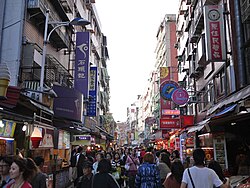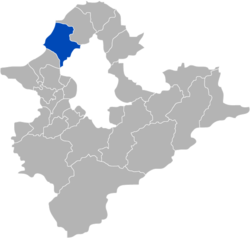Tamsui
|
Tamsui 淡水區 Danshui |
|
|---|---|
| District | |
| Tamsui District | |
 |
|
 Tamsui District in New Taipei City |
|
| Coordinates: 25°10′19″N 121°26′38″E / 25.17194°N 121.44389°ECoordinates: 25°10′19″N 121°26′38″E / 25.17194°N 121.44389°E | |
| Country | Taiwan |
| Special municipality | New Taipei City |
| Population (January 2016) | |
| • Total | 162,441 |
| Time zone | +8 |
| Website | www.tamsui.ntpc.gov.tw |
| Tamsui | |||||||||||||
| Chinese | |||||||||||||
|---|---|---|---|---|---|---|---|---|---|---|---|---|---|
| Postal | Tamsui | ||||||||||||
|
|||||||||||||
| Hobe | |||||||||||||
| Traditional Chinese | |||||||||||||
|
|||||||||||||
| Transcriptions | |
|---|---|
| Standard Mandarin | |
| Hanyu Pinyin | Dànshuǐ |
| Wade–Giles | Tan-shui |
| Southern Min | |
| Hokkien POJ | Tām-chúi |
| Transcriptions | |
|---|---|
| Standard Mandarin | |
| Hanyu Pinyin | Hùwěi |
| Southern Min | |
| Hokkien POJ | Hō͘-bé |
Tamsui is a sea-side district in New Taipei, Taiwan. It is named after the Tamsui River; the name means "fresh water". The town is popular as a site for viewing the sun setting into the Taiwan Strait. Though modest in size (population 162,441), the district is home to three universities (Aletheia University, Tamkang University, and St. John's University) and has a large role in Taiwanese culture.
Originally settled by the Ketagalan aborigines, the location was called Hoba, meaning "stream's mouth". Hoba was loaned into Taiwanese Hokkien as Hobe. Historical works in English have referred to the place as "Hobe", "Hobé", or "Hobe Village". The Spanish arrived in the 17th century and called this place Casidor and the Tamsui River Kimalon. Dutch records have used the placenames Tamsuy and Tampsui to refer to this area, but have also referred to another "Lower Tamsuy" in the south of the island.
In his 1903 book The Island of Formosa, former US diplomat James W. Davidson related that the spelling and pronunciation of the placename (淡水) has been given in many variants by "as many so-called authorities. Tamsui, Tamshuy, Tamshui, Tamsoui, Tan-sui,...". The first variant "Tamsui" is consistent with Hokkien literary readings, and (possibly by chance) is equal to the Church Romanization of an older pronunciation (Tām-súi) minus tone markings and hyphen. The variant "Tan-sui", with exception of the hyphen, is consistent with the romanization of Japanese. However, the first variant was apparently already well-known circa 1900, and features prominently in two English-language maps of the same era. Furthermore, at that time, the term "Tamsui" was used "in a most liberal way; it may mean the harbor, the river, the village of Hobe, Twatutia, or Banka, and it may mean the whole district."
...
Wikipedia
